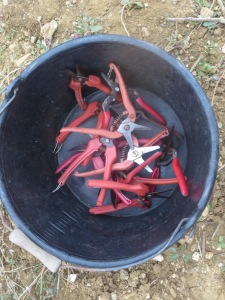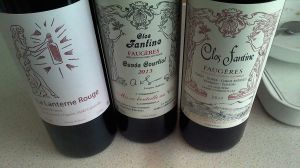When I first became interested in Languedoc wines it is fair to say that Leon Stolarski was the catalyst. I became aware of his online wine sales and bought bottles from his list from a number of producers such as Turner Pageot, Treloar and Domaine De Cébène. When we first came down here on holiday in 2010 and 2011 it was to those producers that I made visits.
Brigitte Chevalier runs Cébène having bought her first vineyards in Faugères around 2007 and making her first vintage in 2008. Visiting her in 2011 she took us round the vineyards and was clearly excited by the potential of the schist soils and old vines. At the time Brigitte worked from an older cellar though it was still able to work through gravity for the grapes to fall into tank when returned to the cellar. Brigitte’s talents were soon recognised around the world and critics such as Jancis Robinson have been very supportive.
I have been fortunate to meet Brigitte many times over the years and her wines are always of such high quality. It was a real treat for me though when Leon contacted me on Saturday from his holiday home down here to invite me to go along with him to taste recent wines at Cébène. It was actually a wet and grey day and mist hung around the new cellars and tasting room at the domaine. However, Brigitte’s welcome was warm despite suffering from an injured foot having slipped in the cellar a couple of weeks ago.
As we talked Brigitte repeatedly talked about her belief in biodynamics and how she feels that the preparations and practices of the philosophy have improved the soils and health of the vines. For example, having checked with the previous owner, Brigitte thinks that some of the Mourvèdre vines are around 100 years old but their yields remain generous and their health excellent. She is relentless in seeking to improve her wines and has invested in amphorae and concrete eggs for fermentations. These vessels from history have become a tool for modern winemakers. Many believe that the shape of amphorae and eggs helps the purity of the wine as there are no angles in the vessel meaning that the wine continuously moves, like a vortex. Brigitte mentioned that she wanted to remove secondary, clashing flavours in the wine, eg oak flavours from barrels, even old barrels. The aim is to produce a more precise, pure wine, the taste of the grapes alone. This desire to improve quality is what shapes her talent.
Brigitte kindly opened examples of all five of the Cébène range. I have to confess that my sheet of notes was lost in the rain so I will keep my assessments brief.
First came Ex Arena 2020, 85% Grenache made from vines outside of the Faugères appellation (actually not far from Jeff Coutelou) on villefranchien limestone soil. Generous, open and plummy fruits this wine is ready to drink now or keep for a few years.
Next, a new bottle to the range is À La Venvole, first produced in 2019 though we tasted the 2020. The name of the wine is from old French meaning by chance, a whim but Brigitte liked the fact that ‘vent’ is is the name, a reference to the winds which are a feature high in the hills. A blend of Syrah, Grenache, Carignan and Mourvèdre, the wine is meant to be drunk young and as a simpler style. I really enjoyed this, yes it is easy to drink young but it has real quality and depth, a lovely blend of grapes and style.
To Bancels, a wine which I have always enjoyed most of all Brigitte’s wines. It was interesting to hear her tell us that this reflects the domaine perhaps most of all the wines. Grenache, Syrah and Mourvèdre grapes from vines around the heart of the vineyard Brigitte keeps the bottles herself in storage until she feels that the wine is ready. It is tempting to open bottles as soon as you buy them and Brigitte wants her customers to enjoy Bancels at its best, not too young. A costly but thoughtful and principled stand by her. The 2017 was still energetic and will age well but is drinking well now with blackberry, spice and floral notes. The 2019 was still a baby and tighter as you’d expect but nice liquorice notes, perhaps a little weightier than the 17, will it stay that way as it develops?
Belle Lurette is the showcase for the Carignan grape, and my word, this was a treat. The 2018 is as good a wine as I have tasted in a long time. To keep the Faugères appellation Brigitte has to add some other grapes but Carignan dominates to the maximum 85% demanded by the appellation. This is the perfect example of how the vines and wines have improved in her care, Belle Lurette has blossomed into a real star. The 2018 was poised, elegant, direct yet rich and powerful with persistent fruit and freshness. Stunning. The 2020 is obviously a baby but drinking well now, though I’d keep it tucked away for a few years. I picked up more dark fruits than the 18 but that poise was evident again. And both bottles showed how good Carignan can be, the altitude (300m), sun and wind combining so well. As Brigitte said it is a terroir made for Carignan and also climate change proof (hopefully).
Finally Felgaria, the flagship wine and a demonstration of the quality of Mourvèdre which makes up at least half of the wine along with Syrah and Grenache. Brigitte credits three factors for producing top quality Mourvèdre, the altitude, the schist soils and the old south facing vines soaking up sunshine. Most of her vines face north, including the Syrah and Grenache topping up Felgaria but Mourvèdre, and especially these very old vines, seems to enjoy a dry, warm situation. It also produces a vibrant red coloured juice and Felgaria is rich in colour with equally enticing aromas and flavours ranging from blackcurrant to citrus, spicy with hints of meatiness, leather and herbs. The 2017 we tasted was plummy, rich and still an infant. Felgaria demands patience and time for it to reach its peak.
It was a terrific couple of hours spent with a winemaker of singular talents, passion and warmth. Wines of elegance, drinking pleasure but also wines which reflect the land upon which the grapes are grown. Brigitte’s wines would be very high on my list of recommendations for people asking for the best Languedoc and Faugères wines. That Belle Lurette 18 will stay in my memory for a long time to come, reflecting its name. Merci Brigitte.









































































